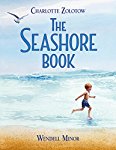There are some children's book authors and illustrators out there who have a gift for capturing golden childhood moments; moments like the joy of playing in puddles, and the happiness that children experience when they spray each other with a garden hose. These are everyday experiences, and yet they are precious all the same. Shirley Hughes is one of these author illustrators, and today I bring a poetry picture book that she created. The title is packed with those glorious moments that make life rich and worthwhile.
 Out and About: A first book of poems
Out and About: A first book of poems
 Out and About: A first book of poems
Out and About: A first book of poems
Shirley Hughes
Poetry Picture Book
For ages 5 to 7
Candlewick Press, 2015, 978-0763676445
It is spring and a little girl, wearing a pair of shiny,
new wellington boots, runs down the front path, a stick in hand, eager to “scamper
and shout.” There is so much to do and see at this time of year, and the little
girl is delighted when she finds some wonderful mud puddles. There is nothing
like playing in mud that is “slippy, sloppy, squelchy.”
Of course, mud
only comes about when there is rain. All too often spring is a rainy time of
year. It is a time of “Wet umbrellas” and, alas, the “Running noses, / Damp
feet” that often go with wet weather.
Soon enough, overcast
skies fade away and the sun comes out. Summer arrives, the days get warm, and
the little girl can indulge her love of water, this time by going to the
swimming pool, by sloshing it out of buckets and spraying it out of a hose. A
baby pool full of water in a garden offers hours of entertainment for the
little girl, her little brother and their friends. Spraying hoses produce lots
of “shrieks,” laughter, and wonderful “Squirting rainbows.”
Fall is a time
for “feasts” for people and animals alike. The little girl goes to the farmer’s
market with her mother and brother to get “juicy plums and stripy marrows” and
pumpkins for Hallowe’en. Mice gather grains of barley, birds eat berries, and
squirrels “hoard nuts.”
Winter brings
misty mornings and sometimes sick days, which are hard to bear. All the little
girl can think about as she lies in bed, fretting, is “When will I be better? /
When can I get up?” Thankfully this is also the time of year when Christmas
comes, bringing with it “Decorations / On a tree,” “hot mince pies” and “A
Christmas surprise!”
This lovely
collection of little poems beautifully captures the joys and woes of a little
child’s life as the seasons unfold. Delightful, heart-warming illustrations
take us in to the little girl’s world and they remind us that so many gifts
wait for us when we are out and about.







